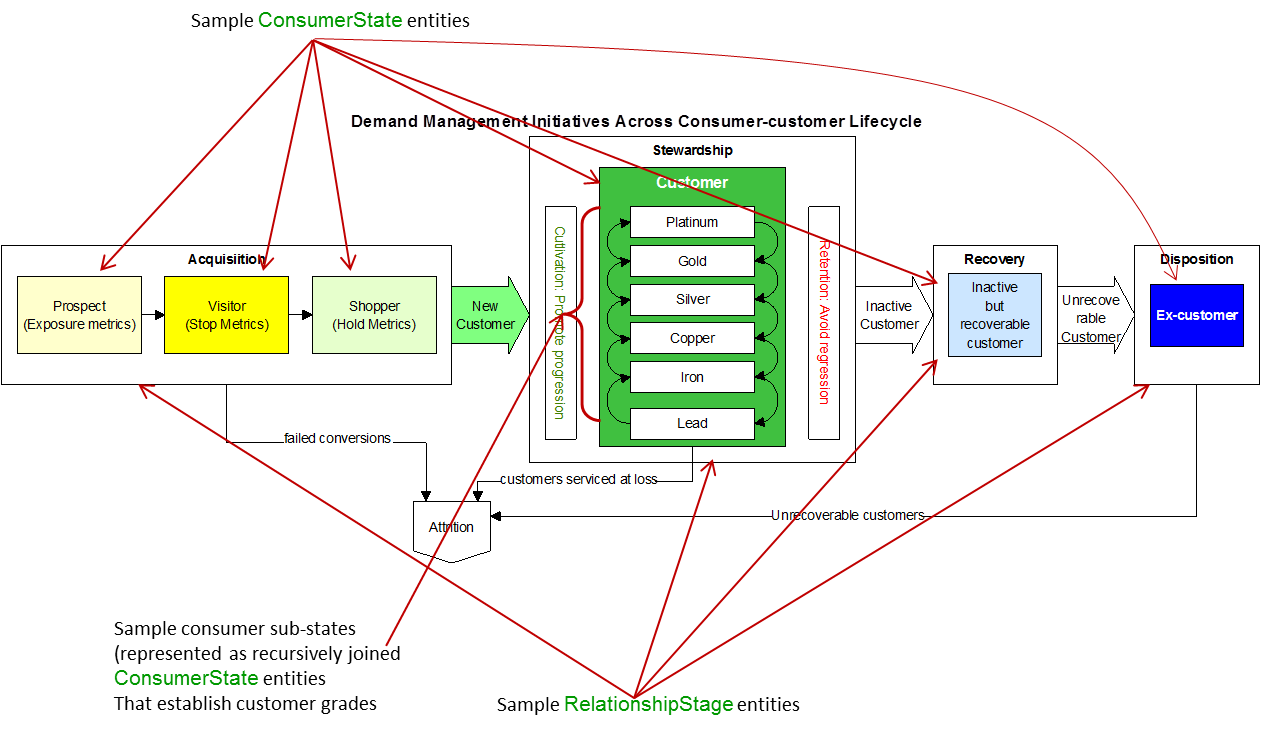Subject Area Concepts The Logical 07015 - Customer Lifecycle and Registration subject area contains the core entities and relationships that the ARTS ODM Version 7 uses to support the concepts discussed in the preceding Consumer-Customer Journey theme. This subject area presents only the core entities used to model consumer-customer lifetime journey. As discussed earlier, a Customer is a Consumer that exists in a specific state (represented by the ConsumerConversionState entity type). The entities in the pink block of the entity model define and capture a retailer's specific customer lifecycle business model. Retailer Defined Consumer-Customer Lifecycle (Blue Area)The notational customer lifecycle model illustrated in the Consumer-Customer Journey topic is a sample used to show what a consumer-customer journey looks like. It is not a formal part of the ARTS ODM V7.0 design. The ARTS ODM V7.0 allows retailers to identify, name, define and organize their own consumer-customer lifecycle. The entity types shown in the light blue block labeled Retailer Defined Model for Consume-Customer Journey contain the attributes and are related in a way that retailers can construct their own specific consumer-customer journey. Retailers begin by organizing their consumer-customer lifecycle into a sequential set of named RelationshipStage entity types. A RelationshipStage identifies, names and describes a high-level phase of development of a customer relationship. RelationshipStage serves as a container for ConversionState entity instances as illustrated in the following diagram. Figure 22 - Example of RelationshipStage and ConversionState Entities
Retailers decide what consumer state transitions are important to their business. They are enumerated and defined in the ConversionState entity type. The customer journey is represented as a sequence of ConversionState entities linked through a self referencing foreign key. At this point in the development of the ARTS model this structure is being represented simplistically and may be extended as more feedback is provided from users of the data model. Retailers link conversion states to one or more ConversionGoals which in turn are translated into observable customer behaviors in the ConversionBehaviorType entity. ConversionInitiatives (in the light green block) identify retailer actions taken to achieve a specific ConversionGoal. ConversionInitiatives may be linked to promotions and other retailer initiatives designed to create consumer demand. As used in ARTS, ConversionInitiative serves as the connection between a retailer's business strategy (represented as promotions, preferred customer services, entry into elite loyalty programs, etc.) and a ConversionGoal. This connection is important because it sets up a feedback loop that allows retailers to measure the conversion outcomes achieved through a given conversion initiative. This structure enables return on investment kinds of analysis for advertising and other historically hard to measure activities related to demand generation. Consumer-Customer Journey - A History of What Actually HappensThe entity types in the yellow block capture the actual consumer-customer conversion state changes and the specific events that trigger those changes. It provides the feedback loop needed to measure the impact retailer conversion initiatives have on customer behavior and serves as the basis for assessing the cost/benefit of advertising, promotions, etc. The ConsumerConversionState entity captures each consumer's journey one conversion event at at time. Only one ConsumerConversionState is an "active" state at any point in time. The ConversionEvent entity captures the point in time, place, channel, location and other contextual information about the consumer state transition. It is the link back to ARTS retail transaction and, in the future, to non-transactional interactions between a retailer and consumers. As shown, a Customer represents a Consumer that is in a "customer" state - i.e. they purchased something from the retailer. Visitor represents consumer in a pre-customer state. Visitors are consumers that landed on the retailers web site or stopped in a store. The Visitor consumer state entity is separately modeled because it requires additional owned attributes that distinguish it from Customer and ConsumerConversionState. Retailers, as they introduce their own ConversionState entity type instances may need to append supplementary attributive entity types to qualify ConsumerConversionState descriptions. Registration StateThe salmon colored block contains the entity types related to consumer registration. RegistrationState identifies, defines and describes different conditions a retailer chooses to use to classify consumer enrollment conditions. Consumers enroll or register with a retailer which means they voluntarily share their name, contact and other identifying information with a retailer. In most scenarios this sharing of personal information is part of an order process. The ConsumerRegistrationState entity captures the registration status of a consumer and provides attributes to document the consumer's privacy preferences. The issue of privacy is a major concern for retailers and will be addressed more extensively in future versions of the ARTS Data Model. It is possible for consumers to enroll and establish a memorialized identity with a retailer without actually ordering items or settling a retail transaction. Accordingly, it is tracked independently of a ConversionsState. It is a separate, "parallel" state. The RegistrationEvent captures the time, place and other context about the change in a consumer's registration state. Registration is an important concept because it separates KeyCustomers (customers that are known to a retailer and may be contacted by them) and anonymous customers (customers who purchase products but have not shared any identification or contact information with the retailer). Each retailer may approach the issue of registration differently based on their business model. ARTS supports retail strategies that involve both known and anonymous customers (represented as an Anonymous sub-type of Party). |
